The Battle of Lepanto - 1571
February 9, 2023
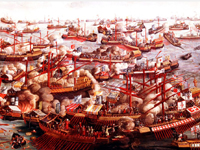
The Battle of Lepanto was fought on October 7th of 1571 between the Ottoman Empire and a Christian coalition named The Holy League. It is the last great clash of navies using oar powered vessels, before the arrival of the age of sail. It is important because it showed Europe that the Ottomans could be defeated, and that European civilization was a formidable force when it could unite.
The Ottoman Empire began as a small Turkish emirate in the late 13th century in modern day Turkey. They quickly expanded, and by 1453 the Byzantine Empire was put to rest when Ottoman Sultan Mehmed II conquered its capital city of Constantinople. Byzantine refugees flocked west, bringing many books along with them, including Greek texts, helping to spark The Renaissance in Europe.
Now sharing a border with Europe, the Ottomans routinely clash with Russians, Austrians, and Venetians. Repeated efforts were made to prevent a takeover of Europe. But nothing could slow the Sultan's expansion...
God Rest You Merry Gentlemen
December 16, 2022
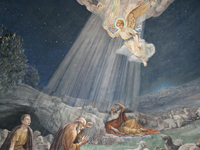
God Rest You Merry Gentlemen is a Christmas Carol inspired by the story in Luke 2:8-20. It tells of shepherds standing out in a field, watching their flock of sheep at night. They are met with the presence of an angel, and are terribly frightened. The angel tells them not to be afraid, for Jesus is born that night in a manger in Bethlehem.
The lyrics of the carol express the message given by an angel to shepherds. 'God rest you merry' means, 'God keep you merry'. This follows with the shepherds traveling to Bethlehem and greeting Mary, Joseph, and Jesus. The carol ends wishing that all who know Christ will enjoy many more Christmases with their friends and family...
The Druids
October 8, 2022

The Druids were a religious and social order that flourished from the 4th century BC to the 2nd century AD. Their religious traditions can, however, be traced back to at least 3000 BC. They mainly occupied the Island of Britain, Ireland, and parts of northern Gaul (modern day France).
There is much debate on where the Druid people came from. Our classical texts determine that they originated as a mixture of indigenous neolithic tribes of Britain and the Celts who came from the East in a wave of Indo-European migration around 2000 BC.
Druid tradition was mainly handed down to successive generations by oral tradition. Refraining from writing trains the memory, and keeps knowledge to the few. Druid priests did not want to leave behind any historical artifacts or sacred texts. They saw themselves as keepers of ancient and ancestral traditions and culture...
The Gartan Mother's Lullaby
June 11, 2022

The Gartan Mother's Lullaby is a wonderful song composed in Ireland at the very end of the Romantic Era. It was penned by Joseph Campbell (1879-1944), an Irish poet and lyricist who wrote under the Gaelic form of his name, Seosamh MacCathmhaoil. He came from a fairly well to do family of road builders in Belfast, but he found his passion in writing poetry.
He travelled to Dublin in 1902 where he was involved in nationalist movements, and collaborated with composer and folk-song arranger Herbert Hughes (1882-1937). Both were from Belfast, Hughes being a Protestant (Methodist) and Campbell a Catholic.
Hughes had collected the traditional melody in Donegal in 1903 when a local had sung him a tune she remembered from her childhood. The words to the original song had long since been forgotten. Campbell added the lyrics from one of his many poems. The song was first published in 1904 in "The Songs of Uladh."
Keeping Time with Earth's Axial Precession
March 20, 2022
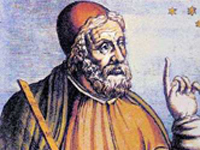
Greek astronomer Hipparchus of Nicea was the first person to compare celestial observations recorded centuries apart. He noticed that the positions of stars apeared to gradually shift. Around the year 130 BC, Hipparchus used ancient observations from the Babylonians, Meton of Athens (fifth century BC), Eratosthenes, and others, and compared them to his own. He concluded that in the preceding 169 years those intersections had moved by 2 degrees.
He was able to measure this change by compairing readings taken during one specific day of the year, the Spring Equinox. Twice per year, the durations of day and night are equal, and the Sun rises exaclty in the east and sets exactly in the west.
Hipparchus concluded that the intersection marking the equinox slowly crept forward along the ecliptic, and called that motion "the precession of the equinoxes. " The rate is about one full circle in 26,000 years...
Bronze Age Civilization Collapse - 1200 BC
February 5, 2022
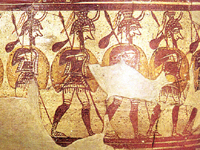
The Bronze Age began around 3000 BC and ended circa 1200 BC. The major powers of this age include the Egyptians, Minoans, Hittites, Assyrians, and Babylonians. These civilizations would ultimately fall with catastrophic events resulting in the first recorded Dark Age.
The ending of the Bronze Age and the subsequent Dark Age that followed is a catastrophic event that is still not completely understood. How could the major powers of the age fall so quickly? What do we know about the world during this time and what caused this catastrophe?
A type of globalization was in place, as all of the major powers were interconnected. Trade networks exchanged glass, ivory, copper, tin, bronze, perfume, and pottery. Bronze could be seen as the equivalent of our Modern economy's crude oil. It was used for axes, knives, plows, and wheel mechanisms...
Winterfylleth (Ƿinterfylleþ) - October
October 20, 2021
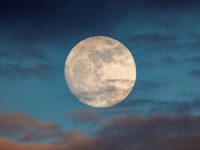
Winterfylleth is the Anglo-Saxon or Old English name for the month of October. The early Anglo-Saxons based their year on the lunar calendar, when a month was marked by the phases of the moon (hence the name monath from the word mona, meaning moon).
Additionally, they divided the year into two parts, Summer and Winter. The beginning of Winter was marked by the first full moon in October. This day was called Samhain, what we now call Halloween. Samhain translates to "The end of Summer."
The Venerable Bede was an English Benedictine monk at the monastery of St. Peter. He wrote many texts on the traditions of the Anglo-Saxon people in the 7th century...
David Livingstone - Missionary and Explorer
July 8, 2021
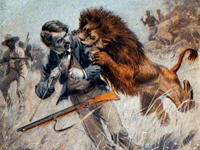
David Livingstone was a famous British explorer and missionary during the 19th century. His primary focus was within the continent of Africa, and his initial motivation was missionary work. In time he became determined to end the slave trade entirely, and saw Christianity and an expanding economy as a means to achieve this goal.
David was born in Scotland in 1813 to a family of modest means. His father bought tea wholesale, and sold it in small bags door to door. He had three younger siblings, and the whole family lived in a single room apartment in the town of Blantyre. His grandfather had a large collection of books, which David borrowed regularly.
He started working in a local factory at the age of 10 to help support the family and pay for his younger sibling's education. His shift was from 6 AM to 8 PM, six days a week. Britain had recently passed a law requiring all factories employing children to offer free education after working hours. After working a 14 hour shift, Livingstone would attend classes...
Jettying - A Unique Architectural Style
March 6, 2021

Jettying is a Medieval technique used in timber framed buildings in which the second story protrudes beyond the walls of the first story floorspace below. This was a rather interesting way to make the most of available resources. It is sometimes referred to as 'garrison' with reference given to military or defensive functionality.
The use of jettying in structural design began in the Medieval Era, sometime after 1000 AD. In time, it became a prominent architectural characteristic during Medieval times, and especially of England's Tudor Era (1485-1603). This was a time in which space was at a premium within town centers, as travel was still dangerous and expensive. It would eventually spread across the Atlantic to be used in many Colonial American towns...
Good King Wenceslas
December 13, 2020
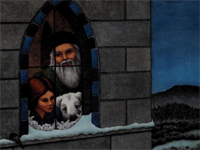
Good King Wenceslas is a Christmas Carol that tells the story of a king's journey through harsh winter weather. His intention is to bring food and firewood to a poor man he notices from the tower of his castle during the Feast of Stephen on December 26, the second day of Christmas.
It is a true story of Saint Wenceslaus I, Duke of Bohemia (c. 907-935 AD). This is the region around Prague in the Czech Republic. Stories of his giving alms to the poor have been told since this time. But it would take many more centuries before these were put into a Christmas carol.
On a cold and snowy night, the good King Wenceslas is enjoying the Feast of Saint Stephen. He looks out over his land, illuminated by moonlight, and notices a poor man gathering firewood for his home...
The Christmas Star
November 29, 2020

The Christmas Star is associated with the story of the wise men and the birth of Jesus as told in the book of Matthew, and is a prominent symbol around Christmastime. Christ's coming was foretold in Numbers 24:17, "There shall come a Star out of Jacob," and in Revelation 22:16 He is called "the bright and morning star."
Jesus was born in Bethlehem of Judea, during the rule of King Herod. Wise men traveled to Jerusalem saying, "Where is he that is born King of the Jews? For we have seen his star in the east, and are come to worship Him." When Herod heard this he was greatly troubled, as was all of Jerusalem. He gathered all of his priests and scribes together and demanded they find where Christ would be born. And they said to him, "In Bethlehem of Judea."
Then Herod called his wise men and asked them what time the star had appeared...
Captain Henry Morgan
October 11, 2020
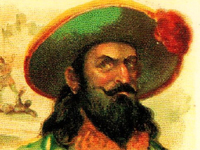
Sir Henry Morgan was born in 1635 in Monmouthshire, Wales, the son of a farmer. As a boy he was sent to work in Barbados. The Caribbean was a hotbed of pirates at this time and young Morgan quickly realized that a life of piracy would bring him far more wealth and adventure. He joined a ship, and his leadership skills soon won him the reputation as a good captain.
Morgan loved the finer things in life, the best wine, delicious foods, and elegant cloths. He saw piracy as the quickest path towards winning these for himself. But he was clever enough to cover his back by making a career in "legitimate" thieving.
In 1667, Britain and Spain signed a treaty in which they promised not to attack each other's ships. This treaty quickly broke down and months later the Spanish were preparing to attack Jamaica from their base in Cuba. The Governor of Jamaica, Sir Thomas Modyford, knew his defenses were inadequate. He called up a mercenary force made of local pirates. ..
Indo-European Migration
October 1, 2020

The Indo-Europeans were a people group originating in the plains of Eastern Europe, north of the Baltic and Caspian Seas in present day Ukraine and southern Russia. They are decendents of the Yamnaya culture. These were rural people who were mainly pastoral agriculturalists and lived during the Neolithic Period (10,200 BC–2000 BC).
There are many theories of how and where these people spread out from their original homeland. Most historical evidence at this time seems to support the Kurgan hypothesis, first proposed in the early 20th century. This theory states that Indo-Europeans migrated out from their homeland and settled new territories including Persia, northern India, and all of Europe.
They seem to be a culture that was obsessed with transportation. By 3500 BC, the Yamnaya people had learned to domesticate horses and knew how to build wagons. This gave them the ability to travel farther and live off of new lands far from their homeland. So it is after this date that we can add new territories to our map that the Indo-European people have settled...
The Siege of Paris and the Paris Commune - 1870
August 7, 2020
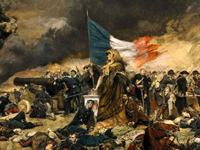
The story of the Siege of Paris begins during the Franco-Prussian war which broke out in July of 1870. Prussian chancellor Otto Von Bismarck sought to unite all of the German kingdoms under one nation-state. He provoked France into declaring war on Prussia, which caused four independent German states to join an alliance with the Northern German Confederation.
On July 16 of 1870, the French Parliament voted to declare war on Prussia. French forces invaded German territory on August 2nd. The German coalition had superior numbers, and made better use of the latest technologies such as railroads and artillery. The Germans invaded northern France on August 4th, and won a series of quick victories. French Emperor Napoleon III was captured and the Second French Empire was decisively defeated.
The German army then marched unopposed towards Paris. The Palace of Versailles was captured and served as the army's headquarters. By the 19th of September, the entire city of Paris was encircled by 240,000 soldiers and cut off from the outside world. Under the command of General Leonhard von Blumenthal, the Siege of Paris had officially begun...
A Brief History of European Forests
May 8, 2020
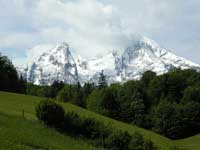
The history of forests in Europe over the past 130,000 years encompasses a wide variety of changes for all parts of the continent. One location could transition from dense deciduous trees to evergreens to barren wind swept arctic tundra as the centuries passed.
We will start with the last interglacial warm period, then go through changes as a result of the last ice age, and finish with the history of European forests during our current interglacial warm period.
Europe experienced a climate period known as the Eemian Warm Period from around 130,000 to 115,000 BC. During this time, Europe was on average about 3.5°F (2°C) warmer than present day temperatures.
Across most of Europe, it seems there were successive waves of various tree species during the Eemian, as the climate was not entirely stable during this 15,000 year period...
The Plague of Athens - 430 BC
April 7, 2020
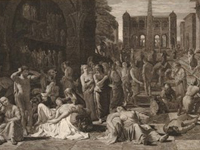
During the Golden Age of Greece in the 5th century BC, a major disease struck which brought Greek society a severe challenge. The epidemic originated in sub-Saharan Africa, just south of Ethiopia. The deadly illness made its way through Libya and Egypt, into Persia and Greece.
The Peloponnesian war (431-404 BC), fought between Athens and Sparta, began one year prior to the epidemic. The Spartans were almost exclusively a land based power and could summon large armies. The Athenians retreated behind city walls and hoped to keep the Spartan supply lines choked off with their superior navy. This strategy unfortunately also added many people from the countryside into the city. As a result, Athens became a breeding ground for disease. This is the primary reason that Athens was most severely affected by the plague...
Starfish Prime and The First Commercial Satellite
January 28, 2020

The first undersea communications cable connecting Europe and North America was laid in 1858 by Cyrus West Field. The trans-Atlantic section of cable began in Ireland and ended in Newfoundland. It initially carried telegraph messages and remained functional for three weeks.
The first transatlantic telephone cable system went into service in 1956 with 36 independent channels. Four cables with a combined 360 telephone lines would connect the two continents by 1965.
At this time over 90% of American households owned a television. But a reliable television signal had yet to be transmitted across the Atlantic Ocean. To transmit video across the Atlantic with conventional ground based radio waves would require a tower 400 miles high, since they cannot transmit around the curvature of the Earth. Telephone lines could have been used, but one telephone line can only transmit 4 KHz of bandwidth, nowhere near the 6 MHz required for the most basic video signal. A better solution was needed...
The First Flight Over the North Pole
December 18, 2019
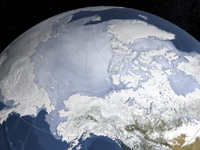
The early 20th century saw a time of extensive polar exploration. The poles were the last terrestrial locations that had yet to be reached by humans.
At first there were many disputed claims of reaching the North Pole from various people. Henson and Peary were the first men confirmed to have reached the North Pole on March 30th, 1911.
On December 14th of 1911, Roald Amundsen became the first man to reach the South Pole. He did this after two failed attempts to reach the North Pole. His first attempt in 1918 was made by lodging a ship in the ice and drifting with it past the North Pole by means of the Transpolar Ocean Current. During this failed excursion Amundsen fell through sea ice and nearly drowned, was attacked by a polar bear, and fell off of the ship breaking his arm.
His second attempt to reach the North Pole was by aircraft starting from the island of Spitsbergen (Svalbard), Norway, in 1925...
Captain James Cook - His Third Voyage
November 6, 2019
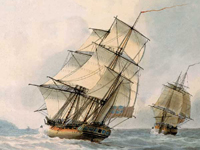
Upon returning from his second voyage in July of 1775, Captain James Cook was granted a captain's berth at the historic Greenwich Hospital, a much sought after position that assured a reasonable income with no excess of duties for the rest of his life. Here at last Cook might have finally settled down, and for a while he did.
His achievements over the past seven years were immense. He had made two tremendous journeys across the Pacific sweeping clear the imaginings of academics, pinned down Antarctica, defeated Cape Horn twice, established sailing routes to Australia and New Zealand, and set up excellent relations with the "noble savages" of the South Seas, the Polynesians. He had accurately mapped the locations of Australia and New Zealand, either achievement would have been a sufficient life's work. He had discovered or rediscovered almost every island group of importance in the South Seas and precisely charted them. He had lead crews of ordinary seamen through shipwreck and hazards in little ships twice around the Earth sailing a total of over 120,000 miles, loosing not one man to scurvy.
James Cook was promoted post Captain, a notable achievement for the ex-mate of a Whitby cat, but long overdue. He was again presented to King George III, and read accounts of his voyages to the Royal Society...
Music List
September 4, 2019
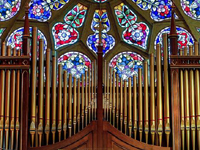
Below is a list of songs that should help to describe the feeling of various points in history. Music is one of the greatest forms of expression available and therefore is one of the best ways to communicate emotion.
As a helpful reference I have created a brief Timeline of Eras in History to help understand the context in which this music was created. An alternative perspective based on the various Eras in Music History alone has also been made. I chose to organize this list based on all encompassing eras in history because its purpose is to choose songs which describe the tone or feeling of living during these times. Dates given are approximately when the songs were written...
The Origins of Summit Crosses
July 27, 2019
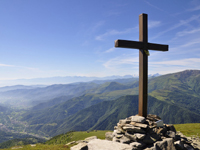
The tradition of erecting crosses at mountain summits or passes dates back to at least the 4th century. The earliest known cross on a higher mountain peak in a Christian context was on the island of Cyprus. Helena, the mother of Roman Emperor Constantine, found the cross in Jerusalem in 327 AD, and brought it to Cyprus, where it was allegedly placed on the top of Mount Olympos. The Council of Ephesus in 431 established the cross as the official Christian symbol.
Sometime before 1100, crusaders set up wooden and iron crosses along their routes to the Holy Land to help mark designated roads. Around the same time in Europe, a cross stood on the Cisa pass in the Pyrenees Mountains, in front of which St. Jacob pilgrims kneeled.
Some locations with crosses dating prior to the 13th century include the Arlberg massif in Austria, the Gardena Pass in Italy, and Birnlücke in a mountain pass on the border of Austria and Italy. These mostly served as trail markers for travelers to stop and pray for continued safety on their journey...
The American Chestnut Tree
April 16, 2019
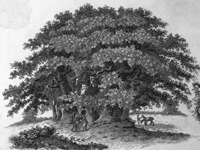
The forests of eastern North America were very different 100 years ago. What we see today is a forest that has experienced the extinction of its keystone species, the American Chestnut Tree. For approximately 40 million years, the American Chestnut made up roughly 25% of the trees from Maine to Florida, and Mississippi to southern Michigan, with a population totaling around 4 billion.
Most Chestnut trees would grow to a height of 100’, with some growing as tall as 150’, and they had massive trunks, some 16 feet in diameter. They grew straight wood, excellent for lumber. Most were nearly barren of branches for about 50 feet, giving them the nickname, “the redwood of the East.”
The forest floor was mostly clear underneath the canopies of the giant trees. A person could have easily ridden a horse at full gallop through some of the deepest parts of the woods without cause for concern...
Breakup of the SR-71 Blackbird at Mach 3+
February 1, 2019

The end of World War II left only two major economic and military superpowers in the world, the United States and the Soviet Union. With each striving for radically different social and economic goals, a cold war emerged in which military conflict was avoided, at least directly. The two powers however did keep a close eye on each other's military capabilities so as to be ready if direct conflict did arise.
As a result, intelligence gathering received a great deal of military funding within the United States. One of the primary means of gathering this intelligence was from aerial imagery onboard aircraft.
Stealth technology for aircraft was still in its infancy at this time and could not be relied upon to be completely foolproof. Therefore the United States Air Force turned to speed as a means to penetrate Soviet defensive systems in order to execute reconnaissance missions...
Frost Fairs on the Thames River
December 8, 2018
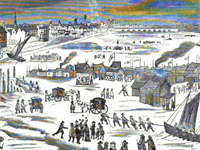
Starting in the mid 14th century, a major climatic change commonly referred to as the Little Ice Age began to take hold. Northern Europe felt the effects in the form of deep freezing temperatures and much heavier snowfalls than normal. The changes became great enough that major rivers began to freeze over during the winter months to a depth of up to three feet.
In England, the colder temperatures helped the lower sections of the Thames River to freeze over completely. But it was more than only climatic changes that caused the river to freeze. Structural changes along and over the river also profoundly altered the flow of the river.
Of all the physical elements that helped the Thames to freeze over, London Bridge helped the most. Constructed from 1176 to 1209, the bridge acted primarily as a defensive barrier against Viking and other invasions...
The History of the Pipe Organ
May 28, 2018

The earliest known use of the term, organon, was used by Plato and Aristotle in the 4th century BC to denote a tool or 'instrument' in a more general sense. In Plato's republic and in the works of later Greek writers, organon denotes any kind or all kinds of musical instruments. In the later periods of Latin, various terms gradually moved from the general sense used in Greek, to something more specific in which the context indicates there was some kind of a musical connection.
St. Augustine correctly explains the Vulgate Latin organum as derived from 'a Greek term': "Organum is a general name of all instruments of Musyk: and is nethelesse specially apropryte to the Instrument that is made of many pypes: and blowe with belowes."
The first pipe organs were conceived and built in Greece around 200 BC...
Captain James Cook - His Second Voyage
February 24, 2018
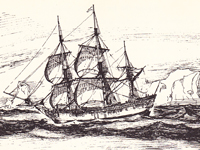
After completing his first voyage through the Pacific in July of 1771, Captain James Cook spent the next year enjoying time with his family while reviewing his charts. It was obvious that no one had yet explored the high latitudes of the South Pacific, that is, closer towards the south pole. It was possible that there was still a good bit to discover there. The theorists of Victorian England had predicted that a continent existed in the South Pacific, to balance the known land masses around the globe. Cook thought the prospect of finding such a continent was dim. The behavior he had observed on the previous voyage of wind patterns, storms, and of the sea, extended his knowledge into areas not yet physically discovered.
But there was still a good case for further exploration. James Cook suggested a voyage that would traverse the South Atlantic and South Indian Oceans, as well as the South Pacific in the high latitudes. At this time, no one knew if such a route was possible. It was Cook's job to find out...
The First Noël - A Christmas Revival
December 6, 2017
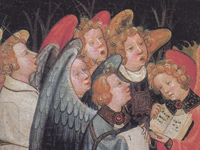
The popular Christmas Carol, The First Noël, is believed to date from the 13th or 14th century, a time in which all medieval civilization in Europe was springing to life. The inspiration for the story of the song comes from dramatizations of favorite Bible stories for holidays, which were called the Miracle Plays, and were very popular during this time. It tells the story of the night that Jesus was born in Bethlehem, based on the Gospel accounts in Luke 2 and Matthew 2. Noël is the French word for Christmas and is from the Latin natalis, meaning "birthday." Most medieval poetry was written to be sung, so it is presumed that the words were written with an existing tune in mind. This makes the tune to the song even older, and is likely English or French.
At the beginning of the 19th century, the singing of Christmas carols was dying out in England. It is Davies Gilbert who is credited with initiating a revival of sorts. 'The First Nowell' was first published in Gilbert's Some Ancient Christmas Carols in 1823. He took it from a manuscript of Cornish carols made around 1817...
The Reformation - 500 Year Anniversary
October 1, 2017
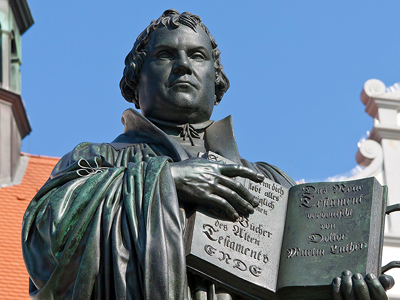
2017 being the 500th anniversary of the beginning of The Reformation, I thought it a good opportunity to briefly write about what is one of the most meaningful and revolutionary movements in all the history of Western Civilization.
In the 16th century, people's religious theology was their most prized possession. The Catholic Church in Rome would not recognise any king as legitimate unless papally confirmed, and granted itself the right to depose kings from their thrones at will. But there was a rising sense of nationalism in all of northern Europe that resented the authority the Pope claimed over all peoples.
The changes in European society starting around the year 1300 included a large range of learned trades, prosperous economies, and a rising spirit of nationalism...
Martin Luther's 95 Theses
October 1, 2017
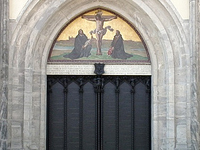
When people brought indulgences to a local monk named Martin Luther asking for him to verify their efficacy, he refuses. The Catholic Church became aware of Luther's refusal and immediately denounced him, bringing him instant notoriety. Luther's response was to quickly compose a ninety-five theses titled: Disputatio pro Declaratione Virtutis Indulgentiarum (Disputation for Clarification of the Power of Indulgences).
Luther nails his theses to the front door of The Castle Church in Wittenberg, Germany on October 31st. The year was 1517 and the Reformation had begun. ..
Early Christian Architecture
May 29, 2017
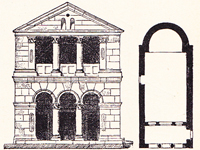
By the end of the first century, it is evident that Christian places of worship had developed a somewhat standard form of architecture. Churches from the 1st through the 3rd centuries took classical Greek and Roman architecture in its most flourished form as its main influence. Classical architecture had at this time reached its height after developing for thousands of years.
The tendency to use Greek and Roman architectural styles was made without reference to their original symbolism. This allowed for a more complete freedom of architectural styles. There were, however, unique designs that were created specifically for churches. One of the few architectural developments made by early churches was the construction of a dome on top of a polygon...
The Love Story of Clara Schumann
May 6, 2017
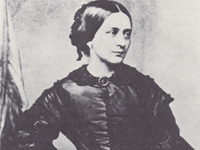
Clara Wieck was born on September 13th, 1819, in Leipzig, Germany near the beginning of what is generally referred to as the Romantic Era in music. Her father, Friedrich Wieck, chose her name because it meant brilliant and bright. He fully expected her to be a brilliant musician, trained by him from birth. She grew up in a household where the sounds of music were heard constantly. Her father gave piano lessons to many students who came and went, and sold instruments at their shop in Leipzig.
The family would go on walks together daily. It was a habit that Clara loved and would later attribute to her health and longevity. An entry into her childhood diary, which her father started for her, reveals that she did not speak until the age of four. Even after she began to speak, her parents assumed that she was hard of hearing because she was so self absorbed and appeared unconcerned with what was happening around her. The myth that she was 'slow' arose because of this.
The Ever Increasing Size of the Known Universe
February 21, 2017
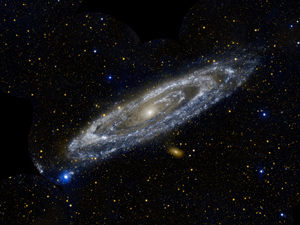
The distance to heavenly bodies as well as the total size of the Universe has been commonly underestimated throughout the entire history of astronomy. From the time of the ancient Greeks and even in recent years, new discoveries have forced us to think bigger about just how vast and distant the Universe is. Currently we have no evidence to prove that the Universe is not infinite in size.
In his time, Aristotle lays down principles of the Universe that would go unchanged for 2000 years. He used philosophy and logic as the basis for his teachings of the natural world instead of experimentation. As such he believed that the Universe was finite, and bounded by a sphere containing the fixed stars.
Outside of the sphere there was nothing. Between this sphere and the moon's orbit was an intermediate region which contained the Sun and all of the planets. The Earth was stationary and at the center of the Universe. Within the Earth-Moon region existed everything that changed. This included thunderstorms, rainbows, comets, etc. Everything beyond the Moon remained the same forever...
The Disappearance of the Great Nomads of Central Asia
January 2, 2017
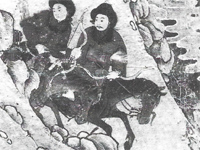
The term 'barbarian' has usually been used by civilized people to refer to any neighboring peoples who might not be as civilized as themselves. Throughout history, the 'barbarians' who posed a real threat to civilization belonged almost entirely to one extraordinary group of men: the nomads from the steppes and deserts in the very center of the Old World. These nomadic tribes consistently plundered a wide range of advanced cultures from China, the Middle East, India, and all the way to Europe. And it was only the Old World that experienced attacks from this extraordinary breed of humanity.
It took only a slight disturbance to set these nomadic horsemen into action and away from their arid pastures. A dispute could break out between tribes, or a drought or population increase would drive them outward in any direction. This usually ended in them invading their neighbor's lands. Their neighbors, in turn, were then set into motion, invading their neighbor's lands as well. As years went by, the effects of these movements extended over thousands of miles across the vast expanse of Asia and Europe...
Welcome new readers!
In a hope to share any interesting historical stories I come across in the future I will be writing and posting articles whenever I can. Hopefully quite often.
I'll also be keeping you up to date on any good reads I come across in the Recommended section.
Looking for something in particular? Find it more quickly on the Search page.
And here is a complete list of all articles since the beginning.
Recent Articles
The Battle of Lepanto - 1571
God Rest You Merry Gentlemen
The Druids
The Gartan Mother's Lullaby
Earth's Axial Precession
Bronze Age Civilization Collapse
Winterfylleth (Ƿinterfylleþ)
David Livingstone
Jettying - Unique Architectural Style
Good King Wenceslas
The Christmas Star
Captain Henry Morgan
Indo-European Migration
The Siege of Paris - 1870
European Forests










